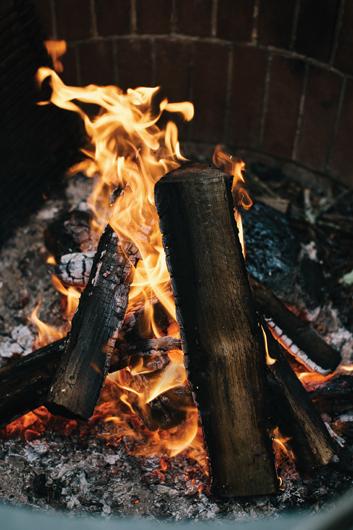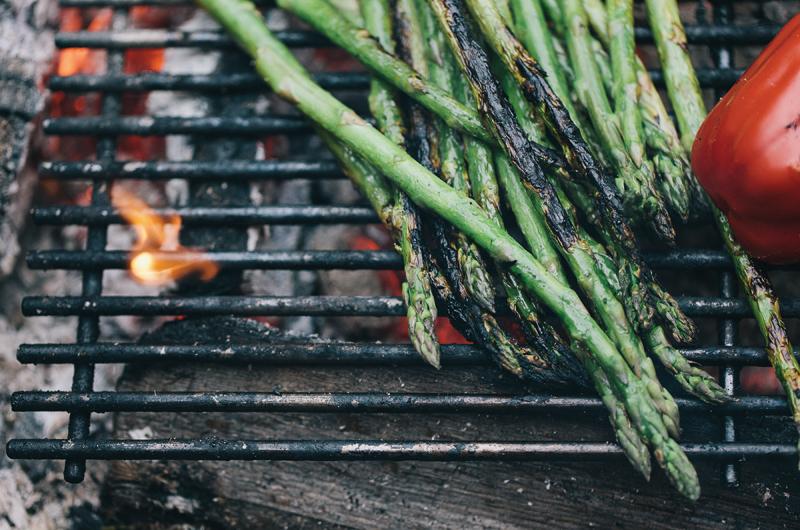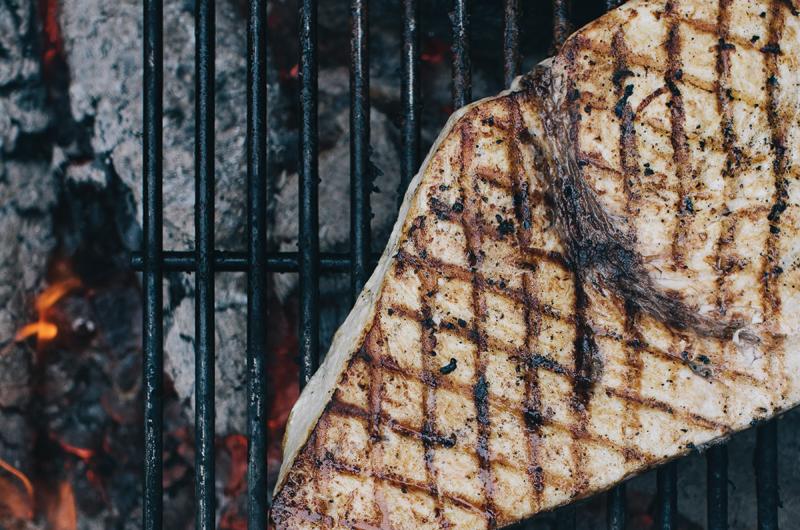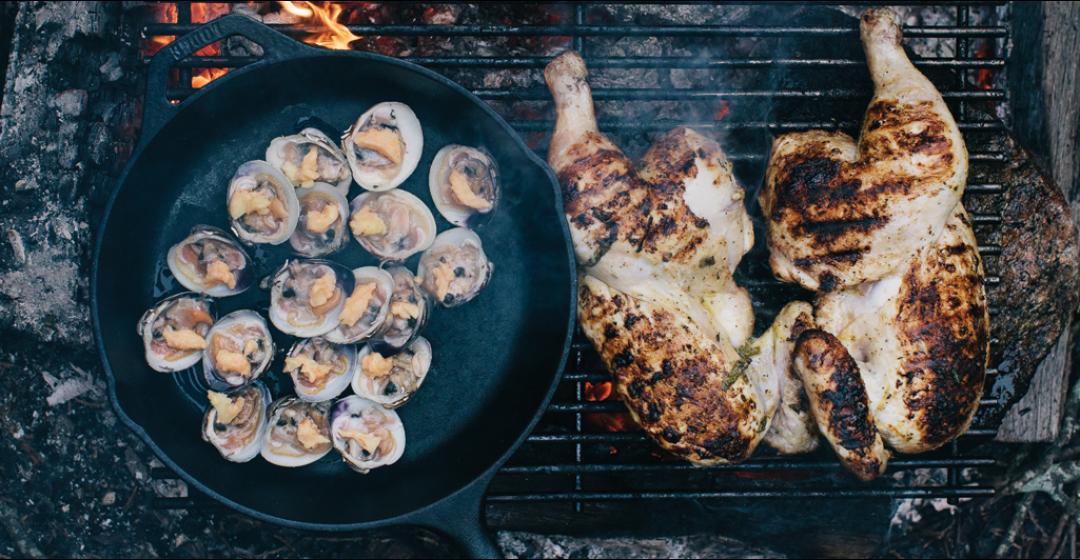There is something magical about fire. Even on a hot summer’s night, it inevitably becomes the focal point, drawing us into its powerful magnetic trance with its dancing light and earthen smells. Fire means warmth, and fire also means food.
Today we cook a lot of our food, but I like to imagine early humans first stumbling upon roasted animals left behind by wildfires. What must it have been like to eat cooked food for the first time – the meat softer, more tender, juicy, and aromatic compared to tough, dry, cold, and I must assume stinky, raw meat? Life was forever changed.
Today, cooking over an open fire is one of the surest signs that summer has arrived and we have moved our lives outside. Most homes now have some type of gas or old-school charcoal grill. But the black box with poor steering and a fat gas tank as a sidekick isn’t quite as alluring as an open fire. Charcoal briquettes work fine, and let’s face it, they are easy. But they don’t compare to the smoky flavors hardwood can add to your meal.
Growing up on the Vineyard, I have always cooked food on open fires, from old-time pig and lamb roasts, to beach clambakes, to sizzling steak in the great fireplace at my grandparents’ house. We say open fire, but the real key to cooking with hardwood is getting the fire to break down the wood into hot coals that will create a consistent temperature without flames.

Our fire pit at home is lined with stone dug into the ground with an old Weber grill grate as the cooking surface. But the pits I have seen on the Island range from do-it-yourself, like ours, to beautifully built and designed brick or fieldstone pits that are the centerpiece to an outdoor living space.
Whatever the fire pit you have or hope to create, be sure there is a protected area around it free of dried grass, debris, and trees. If it’s windy and dry, reschedule or relocate to a conventional grill. And always have a water source or fire extinguisher handy. Just be smart – you can’t enjoy the irreplaceable pleasures of gathering and cooking outside, of creating rustic meals that are bursting with flavor, if you are explaining to the authorities how it is you came to burn down the neighborhood.
The Fire
There is no exact science to making the perfect fire. It is like learning to drive; the more you do it, with patience, the better you become. That said, you want to use clean, seasoned, dry hardwood, which will burn slower than something softer, such as pine. If the wood is wet, dirty, or green, you will get a lot of unnecessary smoke and an inconsistent burn. I like to use oak. Thankfully, there’s plenty of it on the Vineyard.
Much like when you go to a restaurant, you’re looking to create an experience, not just a meal. So relax and give yourself time to create a good fire. I recommend starting it one and a half to two hours in advance, which will allow it to burn down. You need an even temperature to cook, not burn, your food, and for that you want red coals, not open flames. The food you are cooking can activate flames on its own.

One thing to remember: unlike a gas or charcoal grill that sits waist high, fire pits can be low to the ground. Since you will be leaning over sometimes intense heat, you may want to contain certain foods. Try skewering veggies, shrimp, or scallops, or using a grill pan for smaller shellfish.
The Food
Red meat, poultry, and seafood each must be treated differently. I prefer to gently marinate meats and steak-y fish, such as tuna or swordfish, before grilling. Probably the only meat I don’t marinate is hamburger. It just needs salt and pepper.
Marinades impart the flavors of fresh herbs and acids, while the olive oil base keeps things from sticking to the grill. But don’t overdo it: meats need two hours tops, otherwise they’ll lose their natural flavors. For fish or shrimp, thirty to forty-five minutes in the marinade is good enough. The lemon in the marinade can start to cook the fish and change its texture.
I don’t marinate vegetables; I just brush them lightly with the marinade I am using and season to taste.
If you are cooking both meat and fish, start with the meat. It will get the grill greased up so that the fish will not stick as much. Also, the meat can rest at room temperature while your fish is cooking and will be better for it. Shellfish, shrimp, lobsters, and veggies can cook faster and hotter.
Whatever you do, don’t worry the food. My grandfather used to say this about fires in the fireplace. Everyone entering his living room would head right to the fire, grab the fire poker, and start messing with it. Resist the temptation and just leave it alone. When you first put something on the grill, let it cook a minute so that it develops a crust, then you can move it or turn it without any tearing or sticking to the grill.
As for when it’s done? When the meat has cooked for three to six minutes, depending on the heat and thickness, it should be gently seared with grill marks. Once you turn it over, press the meat’s center with your fingers. It will feel squishy, but will firm up as it cooks. Meat will continue to cook once it is removed from the grill, so if it firms up completely before you remove it from the heat, you may have gone too long.
I like to cook chicken on the bone long and slow, on a portion of the grill that receives medium heat. It could take up to thirty minutes. A boneless breast, however, will take a similar amount of time as red meat.
Fish varies by species. Swordfish will become tender and softer as it cooks and should be watched carefully. You do not want to undercook swordfish. There is nothing worse then undercooked swordfish – except overcooked swordfish. Tuna steaks, on the other hand, can be cooked hot and fast. I like to sear the outside and keep the center rare to medium-rare.
Oysters or clams can be placed directly on a grill grate, on racks specifically designed for unshucked shellfish, or in a cast iron pan. I find that a cast iron pan placed directly on the grill is easier to handle, and has the added bonus of preserving the seafood’s briny liquid. It also allows you to add your own flavors, such as fresh herb garlic butter with Sriracha. Remove the shellfish once the shells have opened up – that’s how you know they’re done.

When in doubt, take your food off the fire. You can always put undercooked meats or fish back on, but there is no way to reverse a hockey puck that used
to be a steak.
The Marinade Recipes
Beef
- ¼ cup extra virgin olive oil
- 1 tablespoon Dijon mustard
- 2 tablespoons Worcestershire sauce
- 1 tablespoon balsamic vinegar
- 3 shallots, chopped
- 3 tablespoons fresh marjoram, chopped
- Salt and pepper
Chicken
- 1/3 cup extra virgin olive oil
- 1 lemon, juiced and zested
- 1 tablespoon mustard
- 4 cloves garlic, grated on a microplane
- ½ cup basil, chiffonade
- 2 tablespoons fresh thyme, chopped
- Salt and pepper
Lamb
- 1/3 cup extra virgin olive oil
- 2 tablespoons Dijon mustard
- 4 cloves garlic
- 1 lemon, juiced and zested
- 2 tablespoons rosemary, chopped
- Salt and pepper
Fish
- ¼ cup extra virgin olive oil
- 1 lemon, juiced and zested
- ¼ cup basil, chiffonade
- Salt and pepper







